案例分析范文
案例分析报告范文6篇(完整版)

案例分析报告文6篇案例分析报告文6篇包括以下几个部分i.ii. 绪论公司生产经营情况分析避免去校外网吧,远离无节制上网的环境。
倘若实在有需要,如查阅学习资料、上交课程作业等,则直接到学校电子阅览室。
2) 每次上网不得超过一个半小时。
随身携带小闹钟,并将闹钟的定时器调至一个半小时。
如果超过规定的上网时间,耳边则会响起刺耳的警示铃声和催促录音。
3) 每天坚持约上几个同学打篮球40 分钟。
这种转移能量法,不仅能减少求助者对网络的依赖,改善与同学的关系,恢复正常社会功能,而且还有助于其逐渐克服自卑,提升自我效能感。
4) 早晚盥洗,每天坚持叠被子、收拾课桌,养成良好的个人卫生习惯。
5) 每天坚持写日记,记录网络使用行为,以及学习、身体锻炼等其他活动,并进行自我评价。
第六次咨询:,当然也有34%的同学在300-500 元之间,只有不到8%的同学生活消费在800元以上。
低消费群体的比重与中等消费群体的比重相当.。
这在一定程度上说明了目前的学校分配两极分化并不算太过于极端.。
对许多大学生来说,尽管食物支出仍是当前在校大学生的主要支出之一,但另一方面,大学生们的消费目的已经不再满足于基本的生活消费,他们开始多元化,层次化消费。
走出校园食堂到外聚餐的人与日俱增,周末逛街购物的大学生成群结伴,假期选择外出旅游的大学生也开始越来越多分析这些问题存在的原因大学生自身消费心理的驱使。
大学生受过比较高的教育,与一般社会人不同,他们不仅想受到社会的认可,更需要的是满足自身被尊重的需要。
在马斯洛需求层次中,受尊重的需要处在比较高的层级,这种需求与受教育程度几乎成正比。
因此,大学生有着强烈的尊重需求,这种心理表现在消费中,则体现为对高物质生活的追求。
很多大学生都认为只有自己很有钱,吃穿都高档,才能被同学看得起。
大部分的学生都是通过寻求富裕的物质生活来美化自己的形象,从而满足自身的需求和心理上的平衡。
在这种心理的推动下,在大学生中就产生了重物质享受的风气,这种风气的形成,会影响学生心理的健康发展,易产生很多畸形心理。
案例分析报告范文6篇
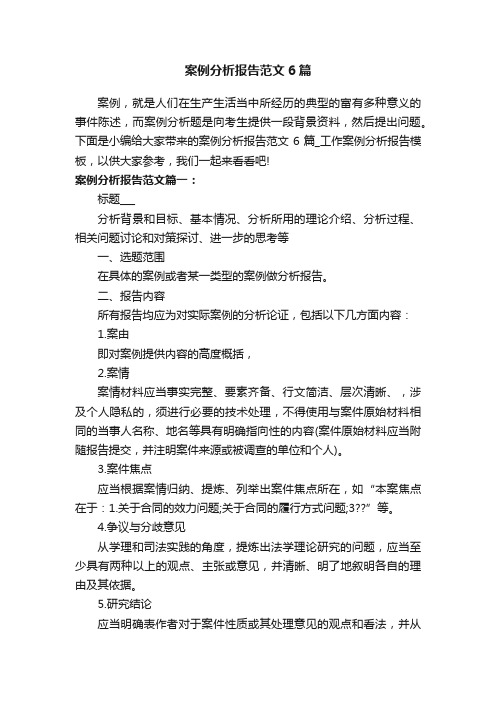
案例分析报告范文6篇案例,就是人们在生产生活当中所经历的典型的富有多种意义的事件陈述,而案例分析题是向考生提供一段背景资料,然后提出问题。
下面是小编给大家带来的案例分析报告范文6篇_工作案例分析报告模板,以供大家参考,我们一起来看看吧!案例分析报告范文篇一:标题___分析背景和目标、基本情况、分析所用的理论介绍、分析过程、相关问题讨论和对策探讨、进一步的思考等一、选题范围在具体的案例或者某一类型的案例做分析报告。
二、报告内容所有报告均应为对实际案例的分析论证,包括以下几方面内容:1.案由即对案例提供内容的高度概括,2.案情案情材料应当事实完整、要素齐备、行文简洁、层次清晰、,涉及个人隐私的,须进行必要的技术处理,不得使用与案件原始材料相同的当事人名称、地名等具有明确指向性的内容(案件原始材料应当附随报告提交,并注明案件来源或被调查的单位和个人)。
3.案件焦点应当根据案情归纳、提炼、列举出案件焦点所在,如“本案焦点在于:1.关于合同的效力问题;关于合同的履行方式问题;3??”等。
4.争议与分歧意见从学理和司法实践的角度,提炼出法学理论研究的问题,应当至少具有两种以上的观点、主张或意见,并清晰、明了地叙明各自的理由及其依据。
5.研究结论应当明确表作者对于案件性质或其处理意见的观点和看法,并从法学理论和法律规定两方面详细阐明其理由和依据,使研究结论有助于解决案例本身,或者为解决类似案件提供有益帮助,或者提出理论上需要深化的问题。
一个完整的案例分析材料应包括以下几个基本要素:摘要关键词正文a) 其中正文包括以下几个部分i.ii. 绪论(包括研究背景,本行业情况,本公司概况) 公司生产经营情况分析(包括公司取得的成绩与存在的问题)iii. 公司拟采取的解决问题的对策分析与相关文献理论(即针对公司存在的问题现拟采取解决措施)iv.v.vi. 基本结论与对策建议案例问题讨论参考文献资料尾页要有参考文献例,参考文献:[1] 甘肃省统计局.甘肃年鉴20_[N] .北京:中国统计出版社,20_.[2] 任家强,董琳瑛.基于空间统计分析的辽宁省县域经济空间差异研究[J].经济地理,____,(9):1435-1438.[3] 胡青峰,张子平.基于_区域经济增长率的空间统计分析研究[J].测绘与空间地理信息,20_,(2):53-55.[4] 潘竟虎,冯兆东.甘肃省区域经济差异时空格局的ESDA-GIS[J].兰州大学学报(自然科学版),2008,(4):45-50.(目录)(正文)5号,宋体,三级标题式,至少3000字。
典型案例分析报告范文6篇

典型案例分析报告范文6篇1. 案例名称:企业经营策略调整案例案例背景该企业是一家传统的制造业企业,产品主要销售给国内市场。
然而,随着国内市场竞争的加剧和消费者需求的变化,该企业的销售额开始下滑。
为了应对市场变化,企业决定进行经营策略调整。
调整内容1.市场调研:企业通过市场研究了解目标市场需求和竞争情况,确定了市场定位和目标群体。
2.产品创新:企业开展研发工作,进行产品创新和升级,以满足消费者对新产品的需求。
3.渠道拓展:企业通过与线上平台合作,拓展了销售渠道,增加了产品的曝光度。
4.品牌推广:企业加大了对品牌的宣传力度,通过广告、推广等方式提升产品知名度和美誉度。
5.价格策略调整:企业根据市场需求和竞争情况,进行了价格策略的调整,以提升产品竞争力。
调整效果经过上述调整,企业的销售额得到了恢复和增长。
市场调研使企业更好地理解了目标市场和消费者需求,产品创新提升了产品的竞争力,渠道拓展和品牌推广增加了产品的曝光度和认知度,价格策略调整提升了产品的市场竞争力。
2. 案例名称:团队合作问题分析案例案例背景某公司的项目团队一直存在合作问题,导致项目进度延误,质量下降,客户投诉增多。
问题分析1.沟通问题:团队成员之间沟通不畅,信息传递不准确,导致任务理解偏差。
2.缺乏目标共识:团队成员对项目的目标理解不一致,导致各自为政,影响整体合作效果。
3.缺乏协作意识:团队成员工作独立,缺乏协作,无法形成高效的工作合力。
4.领导问题:团队领导者缺乏有效沟通和指导能力,未能提供明确的方向和支持。
解决方案1.沟通提升:组织团队成员进行沟通培训,提升沟通技巧和效果。
2.目标明确化:团队领导者与成员一起讨论确定项目目标,并通过团队会议和工作计划明确任务和责任。
3.协作机制建设:鼓励团队成员之间相互交流和协作,建立团队合作机制,促进信息流动和任务完成。
4.领导力提升:团队领导者参加领导力培训,提升沟通、指导和协调能力,更好地领导团队。
典型案例分析报告范文6篇(优秀版)

典型案例分析报告范文6篇(优秀版)1. 《公司A市场营销策略的分析与评估》简介该案例主要关注公司A针对新产品推广所采取的市场营销策略,并对其进行全面的分析和评估。
通过对公司A的市场营销策略的研究,我们可以了解如何制定并执行有效的市场营销策略,从而提高企业的市场竞争力。
1.1 简要总结公司A是一家新兴的科技公司,旨在推广一款基于人工智能的智能家居设备。
为了在市场上取得竞争优势,公司A采取了以下市场营销策略:1.定位目标市场:公司A针对年轻人群体定位,将产品定位为提高生活便利性和智能化的解决方案。
2.渠道分销策略:公司A与多家电商平台和实体店建立合作伙伴关系,通过多渠道分销产品。
3.品牌推广活动:公司A组织线下推广活动、利用社交媒体进行在线宣传,提高品牌知名度。
4.客户关系管理:公司A通过提供个性化的售后服务和定期更新产品功能,增强与客户的长期关系。
1.2 细节分析1.定位目标市场:通过调研发现,年轻人群体对智能家居设备的需求较高,这一群体追求生活便利性和科技感。
因此,公司A准确地将目标市场锁定在年轻人群体上,并针对其需求进行产品设计和市场宣传。
2.渠道分销策略:公司A与多家知名电商平台合作,将产品上架并提供优惠券等促销活动,吸引消费者购买。
同时,公司A也与一些实体店合作,使产品更加容易接触到消费者。
通过多渠道分销,公司A的产品受众面更广,销售量也相应增加。
3.品牌推广活动:公司A主要通过线下推广活动和社交媒体进行品牌推广。
在线下推广活动中,公司A积极参加科技展览会和生活展览会等,展示其产品并与潜在消费者互动。
在社交媒体上,公司A利用微博、微信公众号等渠道发布产品介绍、用户使用心得等内容,吸引用户关注并增加产品曝光度。
4.客户关系管理:公司A重视客户关系的长期维护。
公司A提供24小时在线客服支持,及时回答用户的问题和解决问题。
同时,公司A也定期推送软件更新和产品升级,提供更好的产品体验,并与客户建立长期关系。
案例分析范文优秀11篇

案例分析范文优秀11篇案例分析报告篇一一、20xx年内科护理不良事件汇总:事件类型医嘱漏执行医嘱录机错误漏费或多收费给药错误皮试未填结果医嘱漏签名药液外渗检查单发错合计例数84102121129例比率27.5%13.8%34.5%6.9%3.5%6.9%3.4%3.4% 20xx年内科护理不良事件29例,发生例数最多的护理不良事件是医嘱漏执行,其次是护士站医嘱录机错误造成医嘱执行错误,其他不良事件包括漏收费或多收费,给药错误等。
二、原因分析:造成护理不良事件的主要原因是由于在护理工作中责任心不强、不遵守规章制度、查对制度流于形式、违反操作规程或技术水平低而发生。
1、护士对护士工作站系统操作不熟练,不了解收费标准,医嘱录入后未核对,造成少收费或多收费。
2、查对制度落实不到位:具体表现在用药查对不严,如给病人进行治疗时未严格做到“三查七对”,只喊床号,不喊姓名,更换液体时未做到床号、瓶签、输液卡、三对照,致使给患者输错液体或发错口服药。
3、不严格执行医嘱:表现在盲目的执行医嘱,错抄或漏抄医嘱,有时凭借主观印象,未能及时发现病人用药剂量的更改而对病人造成影响。
对医嘱执行的时间不严格,包括给药时间拖后或提前、错服、漏服、多服药,有的做过敏试验后,未及时观察结果或结果漏填、执行医嘱不及时等。
三、整改措施:1、护士长加强管理,对收费标准进行学习,全科护士进行电脑操作的培训,要求每一名护士必须会操作。
2、认真学习护理核心制度,严格执行医嘱查对制度。
医生下达医嘱后,护士先对医嘱进行认真检查,对有疑问的医嘱查明问清后方可处理。
发放口服药要让家属签字,执行医嘱时必须严格遵守“三查七对”制度,确保医嘱执行准确无误。
科室应组织全体护理人员学习细化查对制度执行流程。
坚持做好班班查对工作,护士长每周查对不少于两次。
3、提高护士安全防范意识,对一些特殊用药一定要有安全警示,可用红笔做标示加以提醒,认真落实操作前、中、后的查对。
案例分析报告范文6篇

案例分析报告范文6篇案例分析报告范文篇一:标题分析背景和目标、基本情况、分析所用的理论介绍、分析过程、相关问题讨论和对策探讨、进一步的思考等一、选题范围在具体的案例或者某一类型的案例做分析报告。
二、报告内容所有报告均应为对实际案例的分析论证,包括以下几方面内容:1.案由即对案例提供内容的高度概括,2.案情案情材料应当事实完整、要素齐备、行文简洁、层次清晰、,涉及个人隐私的,须进行必要的技术处理,不得使用与案件原始材料相同的当事人名称、地名等具有明确指向性的内容(案件原始材料应当附随报告提交,并注明案件来源或被调查的单位和个人)。
3.案件焦点应当根据案情归纳、提炼、列举出案件焦点所在,如本案焦点在于:1.关于合同的效力问题;关于合同的履行方式问题;3等。
4.争议与分歧意见从学理和司法实践的角度,提炼出法学理论研究的问题,应当至少具有两种以上的观点、主张或意见,并清晰、明了地叙明各自的理由及其依据。
5.研究结论应当明确表作者对于案件性质或其处理意见的观点和看法,并从法学理论和法律规定两方面详细阐明其理由和依据,使研究结论有助于解决案例本身,或者为解决类似案件提供有益帮助,或者提出理论上需要深化的问题。
一个完整的案例分析材料应包括以下几个基本要素:摘要关键词正文a) 其中正文包括以下几个部分i.ii. 绪论(包括研究背景,本行业情况,本公司概况) 公司生产经营情况分析(包括公司取得的成绩与存在的问题) iii. 公司拟采取的解决问题的对策分析与相关文献理论(即针对公司存在的问题现拟采取解决措施)iv.v.vi. 基本结论与对策建议案例问题讨论参考文献资料尾页要有参考文献例,参考文献:[1] 甘肃省统计局.甘肃年鉴20xx[N] .北京:中国统计出版社,20xx.[2] 任家强,董琳瑛.基于空间统计分析的辽宁省县域经济空间差异研究[J].经济地理,xxxx,(9):1435-1438.[3] 胡青峰,张子平.基于Geoda095i区域经济增长率的空间统计分析研究[J].测绘与空间地理信息,20xx,(2):53-55.[4] 潘竟虎,冯兆东.甘肃省区域经济差异时空格局的ESDA-GIS[J].兰州大学学报(自然科学版),20xx,(4):45-50.(目录)(正文)5号,宋体,三级标题式,至少3000字。
个案案例分析报告范文6篇

个案案例分析报告范文6篇个案案例分析报告是教育、医疗、社会工作等领域中常用的一种文档形式,它通过对特定个体或事件的深入分析,来提炼问题、总结经验、指导实践。
以下是六篇个案案例分析报告的范文,每篇报告都以不同的案例为背景,展示了个案分析的不同方面。
# 范文一:学生行为问题个案分析报告背景介绍:张三是一名初中生,近期在学校表现出频繁的逃课和暴力行为。
问题分析:通过与张三的家长、老师和同学的访谈,发现张三的行为问题可能与其家庭环境、个人心理状态以及学校环境有关。
解决方案:建议学校为张三提供心理咨询服务,同时与家长合作,改善家庭教育方式,加强学校监管,为张三创造一个更加积极的学习环境。
结论:通过多方面的努力,张三的行为问题得到了一定程度的改善,但仍需持续关注和干预。
# 范文二:医疗误诊个案分析报告背景介绍:李四因持续发热被误诊为普通感冒,实际上患有肺炎。
问题分析:通过对李四的病历和诊断过程的复盘,发现误诊的原因包括症状相似性、医生经验不足以及检查不全面。
解决方案:建议医院加强医生的专业培训,完善诊断流程,并引入更先进的诊断设备。
结论:经过重新诊断和治疗,李四的病情得到了控制,医院的诊断准确性也有所提高。
# 范文三:企业危机管理个案分析报告背景介绍:某企业因产品质量问题引发消费者信任危机。
问题分析:分析发现,危机的根源在于产品质量控制不严和危机公关处理不当。
解决方案:建议企业加强产品质量管理,建立快速响应机制,改善与消费者的沟通方式。
结论:通过有效的危机管理,企业成功挽回了市场信誉,并提高了内部管理水平。
# 范文四:社区服务项目个案分析报告背景介绍:某社区开展老年人健康促进项目,旨在提高老年人的生活质量。
问题分析:项目实施过程中,发现老年人参与度不高,服务内容与需求不匹配。
解决方案:建议项目团队进行需求调研,调整服务内容,增加老年人喜闻乐见的活动。
结论:项目调整后,老年人的参与度和满意度显著提升。
# 范文五:环境影响评估个案分析报告背景介绍:某建设项目在环境影响评估中发现了潜在的生态风险。
案例分析报告范文优秀7篇-最新
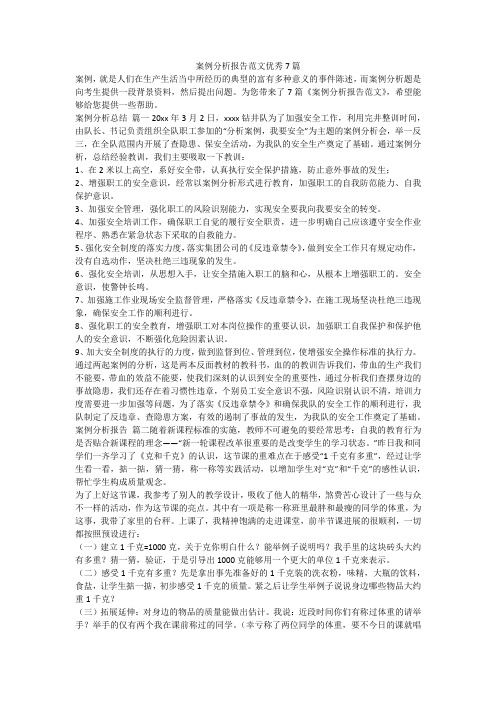
案例分析报告范文优秀7篇案例,就是人们在生产生活当中所经历的典型的富有多种意义的事件陈述,而案例分析题是向考生提供一段背景资料,然后提出问题。
为您带来了7篇《案例分析报告范文》,希望能够给您提供一些帮助。
案例分析总结篇一20xx年3月2日,xxxx钻井队为了加强安全工作,利用完井整训时间,由队长、书记负责组织全队职工参加的“分析案例,我要安全”为主题的案例分析会,举一反三,在全队范围内开展了查隐患、保安全活动,为我队的安全生产奠定了基础。
通过案例分析,总结经验教训,我们主要吸取一下教训:1、在2米以上高空,系好安全带,认真执行安全保护措施,防止意外事故的发生;2、增强职工的安全意识,经常以案例分析形式进行教育,加强职工的自我防范能力、自我保护意识。
3、加强安全管理,强化职工的风险识别能力,实现安全要我向我要安全的转变。
4、加强安全培训工作,确保职工自觉的履行安全职责,进一步明确自己应该遵守安全作业程序、熟悉在紧急状态下采取的自救能力。
5、强化安全制度的落实力度,落实集团公司的《反违章禁令》,做到安全工作只有规定动作,没有自选动作,坚决杜绝三违现象的发生。
6、强化安全培训,从思想入手,让安全措施入职工的脑和心,从根本上增强职工的。
安全意识,使警钟长鸣。
7、加强施工作业现场安全监督管理,严格落实《反违章禁令》,在施工现场坚决杜绝三违现象,确保安全工作的顺利进行。
8、强化职工的安全教育,增强职工对本岗位操作的重要认识,加强职工自我保护和保护他人的安全意识,不断强化危险因素认识。
9、加大安全制度的执行的力度,做到监督到位、管理到位,使增强安全操作标准的执行力。
通过两起案例的分析,这是两本反面教材的教科书,血的的教训告诉我们,带血的生产我们不能要,带血的效益不能要,使我们深刻的认识到安全的重要性,通过分析我们查摆身边的事故隐患,我们还存在着习惯性违章,个别员工安全意识不强,风险识别认识不清,培训力度需要进一步加强等问题,为了落实《反违章禁令》和确保我队的安全工作的顺利进行,我队制定了反违章、查隐患方案,有效的遏制了事故的发生,为我队的安全工作奠定了基础。
案例分析报告范文30篇

案例分析报告范文1:《企业市场营销策略案例分析》案例背景本案例分析报告基于某公司在市场营销方面的策略实施和结果进行分析。
问题陈述该公司面临市场份额下滑和竞争加剧的问题,需要重新评估并优化其市场营销策略。
分析过程为了解决问题,我们首先对该公司的市场定位和目标受众进行了分析。
通过对市场调研和竞争对手分析,我们发现该公司的产品与竞争对手相比,在性能和价格方面并没有明显优势。
因此,我们建议该公司将目标市场定位为高端消费者,提供高品质和高价值的产品。
接下来,我们对该公司的营销渠道进行了评估。
通过分析销售数据和消费者反馈,我们发现该公司的线下销售渠道虽然覆盖面广,但销售效果不尽如人意。
因此,我们建议该公司加强线上销售渠道的开发,利用电子商务平台进行在线销售,并通过互联网渠道增加品牌曝光度。
此外,我们还对该公司的广告和促销策略进行了评估。
通过分析市场调研数据,我们发现该公司的广告投放相对较少,且促销活动不够有吸引力。
因此,我们建议该公司增加广告的投放频率和广度,并设计创意吸引力强的促销活动,以提高品牌知名度和销售额。
最后,我们对该公司的客户关系管理进行了研究。
通过分析客户反馈和售后服务数据,我们发现该公司在客户关系管理方面存在不足,客户忠诚度较低。
因此,我们建议该公司建立健全的客户关系管理系统,加强与客户的沟通和互动,提高客户满意度和忠诚度。
结果和建议经过我们的分析和建议,该公司采取了以下措施:重新定位目标市场,加强线上销售渠道开发,增加广告投放和创新促销活动,以及改进客户关系管理。
在一段时间后,该公司取得了显著的成果。
市场份额逐渐恢复增长,销售额和利润也有了明显提升。
基于以上实际案例,我们认为,对于企业市场营销策略的优化,需要多角度的分析和综合考虑,以确保能够有效应对市场竞争和快速变化的市场环境。
案例分析报告范文样式(优秀4篇)

案例分析报告范文样式(优秀4篇)案例分析经验篇一一、高处不系安全带工作人员把命丧某厂2名作业人员站在空气预热器上部钢结构上,在进行起重挂钩作业时,失去平衡同时跌落,1人死亡。
【简要经过】某年6月12日上午,某厂脱硝改造工作中,作业人员王某和周某站在空气预热器上部钢结构上进行起重挂钩作业,2人在挂钩时因失去平衡同时跌落。
周某安全带挂在安全绳上,坠落后被悬挂在半空;王某未将安全带挂在安全绳上,从标高24m坠落至5m的吹灰管道上,抢救无效死亡。
【原因及暴露问题】1、高处作业未将安全带挂在安全绳上;2、工作负责人不在现场,失去监护。
【知识点】1、高处作业时,应将安全带挂在安全绳上;2、工作负责人应始终在现场认真履行监护职责。
【制度规定】1、《安规》(线路)第条规定“在没有脚手架或者在没有栏杆的脚手架上工作,高度超过时,应使用安全带,或采取其他可靠的安全措施”。
2、《安规》(线路)第条规定“安全带的挂钩或绳子应挂在结实牢固的构件或专为挂安全带用的钢丝绳上”。
二、开关运行位修泵班长合闸险伤人某厂检修人员检修升压泵过程中,运行班长擅自合开关,险造成重大人身伤害。
【简要经过】某年2月27日上午,某厂检修人员检修水源地升压泵。
工作许可人将泵停止运行,在做停电措施时,因380V手车式开关操作机构犯卡,开关未拉至“检修”位,仍在“运行”位。
工作许可人与工作负责人现场确认后,经商定,挂上“禁止合闸有人工作”标示牌,开始检修工作。
在检修过程中,运行班长巡视开关室,发现该升压泵开关仍在“运行”位,擅自取下标示牌,试图拉开关至“检修”位。
在拉开关时按动了“合闸”按钮,开关合闸,已解体的升压泵启动,4名检修人员急忙躲闪,险造成重大人身伤害。
【原因及暴露问题】1、运行人员严重违章,未按工作票要求将开关拉至“检修”位,开关仍在“运行”位便准许工作;2、工作负责人严重违章,明知开关仍在“运行”位,也未做防泵体突然转动措施,同意开工,对工作班成员不负责任;3、运行班长严重违章,未履行操作票手续,擅自进行电气操作。
案例分析报告范文6篇
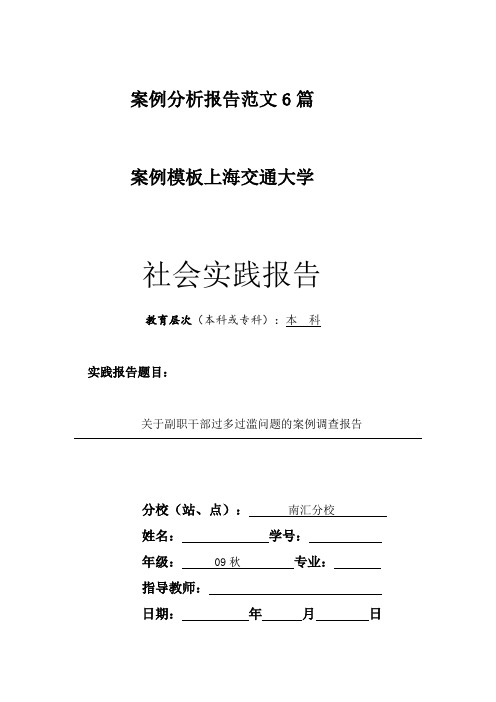
案例分析报告范文6篇案例模板上海交通大学社会实践报告教育层次(本科或专科):本科实践报告题目:关于副职干部过多过滥问题的案例调查报告分校(站、点):南汇分校姓名:学号:年级: 09秋专业:指导教师:日期:年月日提纲一、案例概要(一)案例来源(二)案例内容概要二、案例分析及对策(一)案例中发现的问题(二)行政管理学理论依据(三)解决问题的对策三、分析的结论及其推论(一)结论(二)理论及实践推论(三)感想内容摘要为了适应现实及发展的需要,我们设置了大量的行政副职,但在实际的行政活动及效果中我们却发现由此而来的很多问题。
比如机构臃肿、分工不明、效率低下;副职之间、正副职之间关系复杂,内耗严重;行政层级过多,管理成本过大;副职职责不清,角色不明等等,集中表现为副职的设置过多过滥。
必须遏制“副职过多”现象。
其中有三件事情非做不可:一是减事,基层常常抱怨“上面千条线,下面一根针”,并非没有道理。
所以,减事是减人的前提,政府不该管的事一定要放开,形式主义的事一定要清理,唯有这样,那些忙而无用的岗位才能退出。
二是减支出,公共财政预算的“钱袋子”管住了,吃财政饭的副职“帽子”才会减少。
三是畅出口,干部能上不能下,仍是当前一大突出问题,不出格、不到龄、不惹事,就难以通畅地退出领导岗位。
在“官本位”的思维主导下,干部出口很难拓宽。
当务之急,是要实行严格的干部任期制,届期满了必须退出岗位。
关于副职干部过多过滥问题的案例调查报告一、案例概要(一)案例来源关于副职干部过多过滥问题案例来自于《半月谈》(内部版)2009年第2期。
(二)案例内容概要最近,在陆续召开的地方“两会”上,副职过多的问题也再次成为代表委员的议论话题。
一些地方配备的副市长、副秘书长等竟然超过了两位数。
客观上说,领导干部的职数配备有严格的规定。
特别是十七大前的新一轮地方党委政府换届中,中央对地方党委“副书记”职数作出了减少的统一规定。
但是,在一些地方还是出现了副职干部过多、甚至过滥的问题,副秘书长10多个,副镇长一大桌还坐不下。
法律典型案例分析报告范文6篇
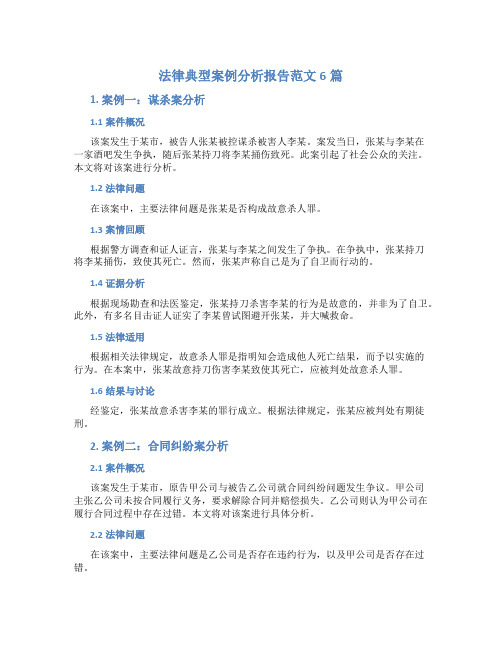
法律典型案例分析报告范文6篇1. 案例一:谋杀案分析1.1案件概况该案发生于某市,被告人张某被控谋杀被害人李某。
案发当日,张某与李某在一家酒吧发生争执,随后张某持刀将李某捅伤致死。
此案引起了社会公众的关注。
本文将对该案进行分析。
1.2法律问题在该案中,主要法律问题是张某是否构成故意杀人罪。
1.3案情回顾根据警方调查和证人证言,张某与李某之间发生了争执。
在争执中,张某持刀将李某捅伤,致使其死亡。
然而,张某声称自己是为了自卫而行动的。
1.4证据分析根据现场勘查和法医鉴定,张某持刀杀害李某的行为是故意的,并非为了自卫。
此外,有多名目击证人证实了李某曾试图避开张某,并大喊救命。
1.5法律适用根据相关法律规定,故意杀人罪是指明知会造成他人死亡结果,而予以实施的行为。
在本案中,张某故意持刀伤害李某致使其死亡,应被判处故意杀人罪。
1.6结果与讨论经鉴定,张某故意杀害李某的罪行成立。
根据法律规定,张某应被判处有期徒刑。
2. 案例二:合同纠纷案分析2.1案件概况该案发生于某市,原告甲公司与被告乙公司就合同纠纷问题发生争议。
甲公司主张乙公司未按合同履行义务,要求解除合同并赔偿损失。
乙公司则认为甲公司在履行合同过程中存在过错。
本文将对该案进行具体分析。
2.2法律问题在该案中,主要法律问题是乙公司是否存在违约行为,以及甲公司是否存在过错。
2.3案情回顾根据甲、乙双方的陈述和证据,甲公司认为乙公司未按合同履行义务,导致甲公司遭受经济损失。
而乙公司则称甲公司在履行合同过程中存在过错,导致乙公司无法履行合同。
2.4证据分析根据合同文本和相关证据,乙公司确实存在未按合同履行义务的行为,而甲公司并未违约。
2.5法律适用根据相关法律规定,合同是双方自愿订立、具有约束力的协议。
在本案中,乙公司未履行合同义务,属于违约行为。
2.6结果与讨论根据合同法的相关规定,乙公司应承担违约责任,赔偿甲公司的损失。
同时,甲公司在本案中未存在过错,不需要承担任何责任。
案例分析报告范文6篇
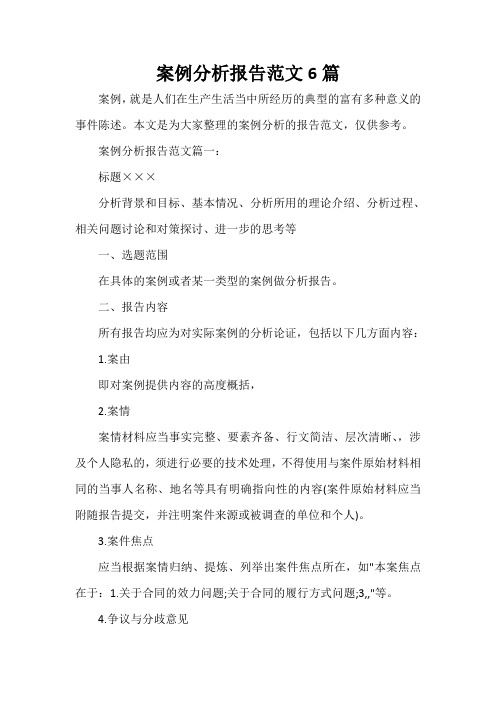
案例分析报告范文6篇案例,就是人们在生产生活当中所经历的典型的富有多种意义的事件陈述。
本文是为大家整理的案例分析的报告范文,仅供参考。
案例分析报告范文篇一:标题×××分析背景和目标、基本情况、分析所用的理论介绍、分析过程、相关问题讨论和对策探讨、进一步的思考等一、选题范围在具体的案例或者某一类型的案例做分析报告。
二、报告内容所有报告均应为对实际案例的分析论证,包括以下几方面内容:1.案由即对案例提供内容的高度概括,2.案情案情材料应当事实完整、要素齐备、行文简洁、层次清晰、,涉及个人隐私的,须进行必要的技术处理,不得使用与案件原始材料相同的当事人名称、地名等具有明确指向性的内容(案件原始材料应当附随报告提交,并注明案件来源或被调查的单位和个人)。
3.案件焦点应当根据案情归纳、提炼、列举出案件焦点所在,如"本案焦点在于:1.关于合同的效力问题;关于合同的履行方式问题;3,,"等。
4.争议与分歧意见从学理和司法实践的角度,提炼出法学理论研究的问题,应当至少具有两种以上的观点、主张或意见,并清晰、明了地叙明各自的理由及其依据。
5.研究结论应当明确表作者对于案件性质或其处理意见的观点和看法,并从法学理论和法律规定两方面详细阐明其理由和依据,使研究结论有助于解决案例本身,或者为解决类似案件提供有益帮助,或者提出理论上需要深化的问题。
一个完整的案例分析材料应包括以下几个基本要素:摘要关键词正文a) 其中正文包括以下几个部分i.ii. 绪论(包括研究背景,本行业情况,本公司概况) 公司生产经营情况分析(包括公司取得的成绩与存在的问题)iii. 公司拟采取的解决问题的对策分析与相关文献理论(即针对公司存在的问题现拟采取解决措施)iv.v.vi. 基本结论与对策建议案例问题讨论参考文献资料尾页要有参考文献例,参考文献:[1] 甘肃省统计局.甘肃年鉴20xx[N] .北京:中国统计出版社,20xx.[2] 任家强,董琳瑛.基于空间统计分析的辽宁省县域经济空间差异研究[J].经济地理,xxxx,(9):1435-1438.[3] 胡青峰,张子平.基于Geoda095i区域经济增长率的空间统计分析研究[J].测绘与空间地理信息,20xx,(2):53-55.[4] 潘竟虎,冯兆东.甘肃省区域经济差异时空格局的ESDA-GIS[J].兰州大学学报(自然科学版),20xx,(4):45-50.(目录)(正文)5号,宋体,三级标题式,至少3000字。
案例分析范文30篇
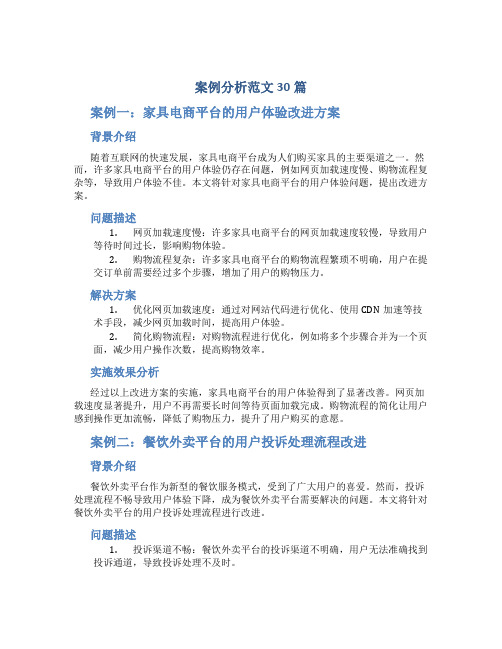
案例分析范文30篇案例一:家具电商平台的用户体验改进方案背景介绍随着互联网的快速发展,家具电商平台成为人们购买家具的主要渠道之一。
然而,许多家具电商平台的用户体验仍存在问题,例如网页加载速度慢、购物流程复杂等,导致用户体验不佳。
本文将针对家具电商平台的用户体验问题,提出改进方案。
问题描述1.网页加载速度慢:许多家具电商平台的网页加载速度较慢,导致用户等待时间过长,影响购物体验。
2.购物流程复杂:许多家具电商平台的购物流程繁琐不明确,用户在提交订单前需要经过多个步骤,增加了用户的购物压力。
解决方案1.优化网页加载速度:通过对网站代码进行优化、使用CDN加速等技术手段,减少网页加载时间,提高用户体验。
2.简化购物流程:对购物流程进行优化,例如将多个步骤合并为一个页面,减少用户操作次数,提高购物效率。
实施效果分析经过以上改进方案的实施,家具电商平台的用户体验得到了显著改善。
网页加载速度显著提升,用户不再需要长时间等待页面加载完成。
购物流程的简化让用户感到操作更加流畅,降低了购物压力,提升了用户购买的意愿。
案例二:餐饮外卖平台的用户投诉处理流程改进背景介绍餐饮外卖平台作为新型的餐饮服务模式,受到了广大用户的喜爱。
然而,投诉处理流程不畅导致用户体验下降,成为餐饮外卖平台需要解决的问题。
本文将针对餐饮外卖平台的用户投诉处理流程进行改进。
问题描述1.投诉渠道不畅:餐饮外卖平台的投诉渠道不明确,用户无法准确找到投诉通道,导致投诉处理不及时。
2.投诉处理流程复杂:餐饮外卖平台的投诉处理流程繁琐,需要用户填写大量信息,导致用户投诉过程不畅。
解决方案1.清晰的投诉渠道:在餐饮外卖平台的界面上设置明确的投诉渠道入口,使用户能够迅速找到进行投诉的通道。
2.简化投诉处理流程:精简投诉处理流程,减少用户填写信息的步骤,提高投诉处理的效率。
实施效果分析经过以上改进方案的实施,餐饮外卖平台的用户投诉处理流程得到了明显改善。
设置明确的投诉渠道入口,使用户能够迅速找到投诉通道,提高了用户投诉的效率。
案例分析报告范文6篇

案例分析报告范文6篇在当今社会,案例分析报告已经成为了各行各业的常见工作之一。
通过对特定案例的深入分析,可以帮助人们更好地了解问题的本质,并找到解决问题的有效途径。
下面,我们将就几个不同领域的案例分析报告范文进行介绍,希望对大家有所帮助。
1. 企业管理领域。
在企业管理领域,案例分析报告通常涉及到市场营销、人力资源管理、财务管理等方面的问题。
一篇优秀的案例分析报告应该包括对企业所面临问题的全面分析,以及针对性的解决方案。
比如,可以通过对某家企业市场营销策略的分析,找出其成功的原因和不足之处,进而提出改进建议,以期达到更好的市场表现。
2. 教育领域。
在教育领域,案例分析报告常常涉及到学校管理、教学方法、学生发展等方面的问题。
一篇优秀的案例分析报告应该包括对学校或教育机构所面临问题的深入挖掘,以及提出可行的改进方案。
比如,可以通过对某所学校教学方法的分析,找出其优势和不足之处,进而提出针对性的改进建议,以期提高教学质量。
3. 医疗卫生领域。
在医疗卫生领域,案例分析报告通常涉及到疾病诊断、治疗方案、医疗资源配置等方面的问题。
一篇优秀的案例分析报告应该包括对病例的全面分析,以及提出有效的治疗方案。
比如,可以通过对某个疾病的诊断和治疗方案的分析,找出其治疗效果的优势和不足之处,进而提出改进建议,以期提高治疗效果。
4. 环境保护领域。
在环境保护领域,案例分析报告通常涉及到环境污染、资源利用、生态保护等方面的问题。
一篇优秀的案例分析报告应该包括对环境问题的深入分析,以及提出可行的改进方案。
比如,可以通过对某个地区的环境污染情况的分析,找出其污染原因和影响,进而提出改进建议,以期改善环境质量。
5. 金融领域。
在金融领域,案例分析报告通常涉及到投资决策、风险管理、金融市场等方面的问题。
一篇优秀的案例分析报告应该包括对金融问题的全面分析,以及提出有效的投资建议。
比如,可以通过对某个投资项目的分析,找出其风险和收益,进而提出投资建议,以期提高投资效益。
案例分析报告范文六篇

案例分析报告范文六篇案例分析报告是学术研究和商业实践中常用的一种文档形式,它通过对特定案例的深入研究,分析问题、提出解决方案,并从中提炼出可供借鉴的经验和教训。
以下是六篇不同领域的案例分析报告范文,每篇约150字,以供参考。
案例分析报告范文一:市场营销策略本案例分析了某知名饮料品牌在新兴市场的营销策略。
通过对市场环境的分析,我们发现品牌通过本地化的广告策略和社交媒体营销,成功吸引了年轻消费者。
案例中特别强调了品牌如何利用社交媒体平台与消费者建立情感联系,并通过限时促销活动增加产品的销量。
最终,品牌在该市场的市场份额显著提升。
案例分析报告范文二:危机管理本文分析了一家航空公司在遭遇突发危机时的管理策略。
危机发生后,公司迅速启动应急预案,通过透明的沟通和积极的公关策略,有效控制了舆论的负面影响。
报告中详细描述了危机管理团队的组成、信息发布流程以及与利益相关者的沟通策略。
通过这一案例,我们学习到了在危机情况下,快速反应和有效沟通的重要性。
案例分析报告范文三:供应链管理本报告探讨了一家电子产品制造商在供应链中断时的应对策略。
由于自然灾害导致原材料供应中断,公司迅速调整供应链,寻找替代供应商,并优化生产流程。
报告中分析了供应链风险评估的重要性,以及在面对不确定性时,灵活调整供应链策略的必要性。
案例分析报告范文四:人力资源管理本文以一家跨国公司为例,分析了其人力资源管理中的绩效评估体系。
报告指出,公司通过实施360度反馈机制,提高了员工的自我认知和团队协作能力。
同时,绩效管理系统与员工发展计划相结合,促进了员工的职业成长和组织的整体发展。
案例分析报告范文五:财务管理本案例分析了一家上市公司在经济衰退期间的财务管理策略。
面对市场需求下降,公司采取了一系列成本控制措施,包括裁员、减少非必要支出和优化资本结构。
报告中强调了在经济不确定性时期,保持财务稳健和现金流管理的重要性。
案例分析报告范文六:技术创新与产品开发本文以一家科技公司为例,分析了其在产品开发过程中的创新策略。
案例分析报告范文6篇

案例分析报告范文6篇篇一:公司A市场扩张分析报告背景公司A是一家创立于2005年的跨国公司,总部位于美国纽约。
近年来,公司A致力于扩张亚洲市场,特别是中国市场。
然而,公司A在中国市场遇到了一些困难,导致市场份额不断下滑。
问题1.市场研究显示公司A在中国市场面临激烈竞争,产品定位不清晰;2.公司A的营销策略与中国消费者文化不符;3.公司A在中国市场的品牌知名度较低,需要提升品牌形象。
分析1.市场份额下滑主要是由于竞争对手产品更符合中国消费者需求,公司A需要针对中国市场重新进行产品定位;2.公司A应该深入了解中国消费者文化,并调整营销策略,符合中国消费者的消费习惯;3.提升公司A在中国市场的品牌知名度,可以通过赞助活动、社交媒体宣传等方式。
建议1.重新定位产品,根据中国消费者需求进行产品改进;2.调整营销策略,符合中国消费者文化;3.提升品牌形象,加大在中国市场的推广力度。
篇二:零售行业电商发展案例分析背景随着互联网的发展,电子商务在零售行业中扮演着越来越重要的角色。
许多传统零售商纷纷转向电商,以适应市场变化。
问题1.传统零售商如何在电商市场立足;2.电商平台如何吸引更多消费者;3.传统零售商与电商平台的合作模式如何选择。
分析1.传统零售商需要建立良好的电商平台,提升商品质量和服务水平,以吸引更多消费者;2.电商平台可以通过个性化推荐、优惠活动等方式吸引更多消费者;3.传统零售商可以选择与电商平台合作,共享资源,互惠互利。
建议1.传统零售商建立专业的电商团队,提高网店运营水平;2.电商平台采取个性化服务,提升消费者购物体验;3.传统零售商与电商平台建立合作模式,共同推动行业发展。
篇三:金融科技创新案例分析背景金融科技在近年来得到迅速发展,为传统金融行业带来许多创新。
许多金融机构开始引入科技元素,提升服务水平。
问题1.金融科技在金融行业中的应用现状及挑战;2.金融科技创新如何改变金融行业生态;3.金融科技企业如何保障数据安全和隐私。
案例分析报告范文格式8篇

案例分析报告范文格式8篇(经典版)编制人:__________________审核人:__________________审批人:__________________编制单位:__________________编制时间:____年____月____日序言下载提示:该文档是本店铺精心编制而成的,希望大家下载后,能够帮助大家解决实际问题。
文档下载后可定制修改,请根据实际需要进行调整和使用,谢谢!并且,本店铺为大家提供各种类型的经典范文,如工作总结、工作计划、活动方案、合同协议、条据文书、讲话致辞、心得体会、教学资料、作文大全、其他范文等等,想了解不同范文格式和写法,敬请关注!Download tips: This document is carefully compiled by this editor. I hope that after you download it, it can help you solve practical problems. The document can be customized and modified after downloading, please adjust and use it according to actual needs, thank you!Moreover, our store provides various types of classic sample essays for everyone, such as work summaries, work plans, activity plans, contract agreements, documents, speeches, experiences, teaching materials, complete essays, and other sample essays. If you want to learn about different sample formats and writing methods, please pay attention!案例分析报告范文格式8篇案例分析报告范文格式(通用8篇)怎么写案例分析报告才合适?看看吧。
案例分析报告范文(通用24篇)

案例分析报告范文(通用24篇)案例分析报告范文一、案例的要素人们在案例分析与挖掘当中,发现无论是哪一种真实案例,都无一例外地包括着以下要素:真实而复杂的情境案例是对一个真实情景的描述。
典型的事件真正的案例描述不是记录流水账,而只是对于非常典型的代表性的情景进行勾画。
也就是说,案例是人们特别关注的焦点处的陈述。
当然要具体简洁交代其焦点产生的背景条件和原委。
多个问题呈现一个案例要显出冲突性、高潮性,必须有多处问题或者疑难问题的出现。
这是案例本身意义所包含的潜在亮点处。
典型的解决方法案例既然是一个非常一般的故事,很多人都关注故事的结局是什么样子的,即有一个或者多个解决方法的记述。
这个结局固然对人们不是很重要,人们完全可以凭借自己的理解去试图猜想解决的方法,但无论如何,故事本身的解决办法无论如何是局外人无法实现过的,这样一来,它是可以起引发或者刺激出新的想法和行为的原型作用的,这也可能是把这样的故事叫作案例的重要原因。
故而要进行抛砖引玉式的点缀。
这种点缀应该只是客观的对事情真相进行中性描写。
以免引起对故事本身的种种不利偏差。
因此,人们在书写一个案例时,基本上要注意突出以上四大要素。
这有助于人们去更好的理解案例,研究案例。
二、案例分析报告范文(通用24篇)在学习、工作生活中,报告与我们的生活紧密相连,不同种类的报告具有不同的用途。
那么什么样的报告才是有效的呢?下面是小编帮大家整理的案例分析报告范文(通用24篇),仅供参考,大家一起来看看吧。
案例分析报告1一、海底捞服务管理案例1996年,海底捞经过两年的努力,店面由原先的70多平方米曾扩到400多平方米。
由于店面扩大,桌数增多,刚开始总是坐不满,生意也平平淡淡。
此时张勇非常着急,但他没有乱了分寸,他知道只有通过更好的服务,让所有消费的顾客都满意,生意才能一步一步好起来。
细心的张勇发现最近总有一对母女俩到店里吃饭,这对母女每次来最多点三样素菜,消费奇低,最多吃十几块钱。
- 1、下载文档前请自行甄别文档内容的完整性,平台不提供额外的编辑、内容补充、找答案等附加服务。
- 2、"仅部分预览"的文档,不可在线预览部分如存在完整性等问题,可反馈申请退款(可完整预览的文档不适用该条件!)。
- 3、如文档侵犯您的权益,请联系客服反馈,我们会尽快为您处理(人工客服工作时间:9:00-18:30)。
案例分析范文案例分析范文Case 1Case description:Although IKEA has recently initiated an American style performance review procedure, which requires documenting employees’ individual performance strengths and weaknesses, Swedish managers feel uncomfortable with the formality of the system and the need to provide negative feedback. Since they hold the more senior positions, their ambivalence has resulted in little real discrimination in pay increases which are directly linked to the reviews. Although turnover at IKEA is lower than the industry average, and coworkers generally appreciate IKEA’s caring environment, there is some latent discontent with the way pay increases are distributed, even among long-term employees who feel that theirindividual achievements are not always rewarded.In the opinion of one American manager, “A lot of people have left IKEA because they can’t move up fast enough here. Some left the store to go to the Service Centre(IKEA’s national headquarters) then left because it was too hard for them to adjust, there was no clear frame of reference in terms of policies and procedures. We have lost some key American managers because they didn’t have a clear idea of their role or future in the organization.”Case 2Case descriptionMr Arthur Aroney, General Manager of Burns Philip and Co. Ltd., and Australian company believes hat businesses should engage in international marketing by investing in target markets. The foreign government offers investment incentiveswhich will encourage the industry “leader”to enter the country and invest. The risks can be high but, if successful, so are the rewards.Burns Philip’s first venture into China, after learning some very hard lessons, was so successful that after three years, it invested more money and doubled the size of a fermentation plant. Burns Philip’s plants are located in Guangdong, Shanghai, Harbin, and in the west. “This gives us coverage in the areas where you find opportunities, particularly a developing middle class with disposable incomes,”says Mr Aroney. In each of its joint ventures burns Philip has encountered different conditions, due to differences in language and culture. The percentage of equity that Burns Philip holds in joint ventures varied according to :1. the requirement of the Chinesegovernment at the time when the jointventure was founded;2. the expected life of the joint venture thatis sought to be established;3. the capability of the joint venture partnerto contribute resources.Mr Aroney says,“All the above can be subject to lengthy negotiations prior to any agreement being reached. The meetings can last for 12 hours at a time, and continue for several days. And each time you go back to the table, the goals seem to have been shifted. It is only with perseverance and a sincere desire to form a joint venture that you achieve your goal.”He adds, “There is the necessary Chinese delegation to Australia with factory visits to examine the technology hat will be used in China, so that a feasibility study can be prepared. Unfortunately, the people that form the delegation are not seen again when negotiations are resumed in China.”Mr Aroney has some concerns about intermediaries in China. He says, “In a country as large as China, the greatest problem facing a manufacturer is not “can you make the product?”but rather “Can you get your product distributed to the marketplace?”The giving of service to customers is practically unknown in China. If you sell through an agent, the agent will wait for a customer to come in and buy; do not expect your agent to go out to sell more of the product since the agent receives the same monthly salary whether the product is sold or not.”According to Mr Arthur Aroney, Burns Philip’s success in China has also been due to the careful selection of work under difficult conditions, surrounded by people who do not speak their language, and with a culture which requires understanding. “People must also understand that they are guests in the country. Once they havesigned a joint venture agreement, that agreement is best placed in a drawer and, hopefully, will never see the light of day. If you have to continually refer to your agreement, you do not have a successful operation,” says Mr Aroney.《跨文化商务交际》案例分析之一1.power distanceFor the Swedish mangers, they hold the more senior position, hey have the right for decision-making in the workplace, and they have the power to make the final decision.2. IndividualismIndividualism in western culture makes career choices on the basis of personal needs and goals. In the United States, individualism is valued. In this case, the IKEA initiated an American style performance review procedure, which required documenting employees’individual performance strengths and weaknesses.However, the IKEA didn’t do reward the employees’individual performance, therefore, the employees felt that their individual achievements were not always rewarded. At last, they left IKEA. 2.Achieved status vs. Ascribed statusAchieved status refers to gaining status or rewards through performance. Ascribed status is about gaining status through other means, such as seniority. Facing with the American style performance review, the Swedish managers felt uncomfortable with the review, but they provided negative feedback. The reason why they did so is because they held the more senior position and higher status in the company, thus their decisions were accepted by employees.《跨文化商务交际》案例分析之二1.Doing and AchievingDoing is important. According to Mr. Arthur, General Manager of Burns Philip, he observed the correlation between cultures and tried his best to understand other cultures. When he first ventured into China, he learned some very hard lessons and invested in the market.2.Thinking and knowingKnowing comes from experience. Burns Philip believed that business should engage in international marketing by investing in target markets. The foreign government offers investment incentives which will encourage the industry “leader”to entry the country and invest, through these activities, they get firsthand experience.3.Long-term and short-term orientationLong-term orientation looks into the future. Short-term orientation stresses past and present. There were difficulties when they found the joint venture, but Burns Philip negotiated with the Chinese government, in order to make the agreement be reached. Why he did so? This is because he and his company wanted to get the rewards from Chinese market.4. Uncertainty avoidanceDifferent cultures will differ from each other in the avoidance of uncertain situation. United States accept uncertainty. In these cultures, people are relatively comfortable with ambiguity. In this case, Burns Philip and his company knew that the risks could be high, but in order to be successful and get the rewards, they encourage the industry “leader” to enter the country and invest.。
